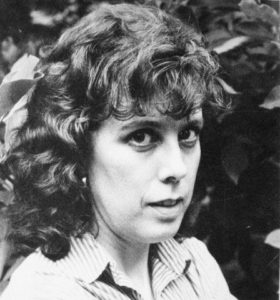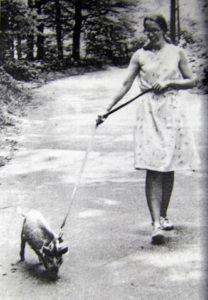
Judith Ripley Goodenough (October 25,1942-September 18, 1990), who wrote as J. B. Goodenough, was a Unitarian Universalist poet and musician.
Judith, also known as Judy, was born to Eva (Ripley) and Robert Fullerton Beach in Berea, Kentucky where her father was a librarian at Berea College. The family lived in Evanston, Illinois while he was a librarian at the Garrett Biblical Institute, 1946-1951; and later in New York City during the years he headed the Union Theological Seminary Library, 1951-1974.
Growing up in New York City, Judy attended the exclusive Birch Wathen School, now the Birch Wathen Lenox School. Her teachers found her to be “bright, intellectual, and extraordinarily talented.” She enjoyed painting, playing the piano, dancing, and writing poetry. During her senior year, she served as editor of the school’s literary publication, Birch Leaves. The class yearbook described her poems as “a perfect balance of interesting and delicate rhythm and artfully chosen words, which convey subtle meanings.” Following graduation in 1960 she enrolled at Radcliffe College, then the coordinate women’s college of Harvard University.
At Harvard Judy majored in English and studied poetry with Mark Van Doren and Robert Lowell. In addition to choral singing and college yearbook work, she participating in Cambridge’s “60s music scene” or as she called it, the “folk thrust.” In 1964 Harvard and Radcliffe jointly awarded her a B.A. cum laude. After college, Judy worked for a year as a secretary at Parish-Hadley Associates, a “posh” interior decorating firm in New York City. She returned to Cambridge in 1965 to take a position at Harvard’s Carpenter Center for the Visual Arts.
At Harvard she met her husband, John Byer Goodenough, who was studying for his Ph.D. in mathematics and working at the United States Air Force, Decision Sciences Laboratory, in nearby Bedford, Massachusetts. Married in 1966, they soon had two children: Anne in 1969 and Elizabeth in 1973.
For the next few years Goodenough took care of her family. As she put it in her 1974 Radcliffe Class report, her “present” career was being a “housewife” and “watching my daughters and roses grow.” The roses referred to her passion for flower gardening. The family’s first home was in the Boston suburb of Westford, which she called “real country” with “horses and farms all around.”
Her poem “25 Old Lowell Road” was written about their house in Westford:
And there are new chairs
In the dining room
And the living room
Is blue and white
And no one has hurt
Anyone yet,
And you tell me I’ve
Obviously forgotten a lot.
And I tell you
Memory is its own
Country and you must leave
Me here, right here
Where no one has hurt
Anyone yet and
The stone wall has
Ivy growing on it
And the road curves just so
In the hot sun
And there are elderberries
Across the road
In 1977 the Goodenough’s relocated to another rural Boston suburb, Carlisle, a community she came to love deeply. She continued writing poetry during these years but also began to do landscapes in acrylics and discovered to her surprise that she had a talent for it. In time she sold almost one hundred works, and when her three collections of poetry were published she illustrated the covers.
Goodenough grew up in a family immersed in the Christian tradition. At work, her father rubbed elbows with many of America’s foremost religious thinkers. In addition to his affiliation with the Garrett Biblical Institute and Union Theological Seminary (home to Reinhold Niebuhr and Paul Tillich), her father also had worked with the American Friends Service Committee and had been a conscientious objector during the Second World War. But Goodenough, during her high school years, came to reject organized religion and took an increasingly dim view of contemporary Christianity. Reacting strongly to the tales her parents brought home of parties and promiscuity among the Union Theological Seminary faculty she turned away from the church.
She returned to religion 20 years later. Wanting to earn some “pocket money” of her own, Goodenough took a part-time church secretary position with the First Religious Society of Carlisle, Massachusetts, a Unitarian Universalist congregation. She found a community that accepted and shared religious beliefs similar to her own, similar to the ideas she expressed in her poetry and music. She was soon attending Sunday services and bringing her children to Sunday school.
By 1978 Goodenough felt her daughters were old enough that she could begin “writing again, after a silence of fifteen years.” She now wrote as J. B. Goodenough. As she told her friend, the Maine folksinger Gordon Bok, she found that “her work was more acceptable to editors by just using her initials.” She said about writing poetry that “the words go where they will, the poem writes itself, and there are forces at work that aren’t ours to deal with.” In a humorous verse she described the process:
…And I hit everything within
reach,’ said Tweedledum
“whether I see it or not!”
Said the Duchess, “I make
a present of everything
I’ve said as yet’
Both of which statements,
Said Judy, are what
writing poetry is all about.”
Before long her poems had been accepted by over one hundred and fifty literary magazines and several had been included in poetry anthologies. Many of these she included in her first book Dower Land (1984). One of the poems in this collection, which Goodenough especially liked is called “Among Vines”:
Wisteria ties the roof
Of the porch down; morning-
Glory anchors the mailbox;
Green peas keep the garden
Fence from taking off.
Trumpet-vine has locked up
The front door that
We never used anyway;
Clematis tries now
To seal the back door.
Benigh root and tendril,
They mean no harm.
I too know a hundred ways
Of holding on. And
No way of letting go.
Writing about Dower Land, poet Denise Levertov said: “The texture of Judith Goodenough’s language is gritty, stony, salty; there’s a direct path between the New England fields, weather, persons, interiors and dreams she writes about and the diction in which she evokes them. She has the gift of seeing with the ears, hearing with the eyes.”
When Goodenough returned to poetry in a serious way she also started to write folk songs, both lyrics and melodies, many of which are related to the sea and Ireland. They are rooted in the

musical traditions of the 1960s, especially the folk culture associated with Harvard Square. These compositions, she explained, are not poems “set to music, that is a different discipline”, but are rather songs “to be sung.” When she sent some to Gordon Bok, he liked them and over the years they “traded poems, songs and inspiration.” He introduced her work to other popular folksingers, particularly Anne Mayo Muir, the Clancy Brothers, and Tommy Makem. “Apples in the Basket” and “Turning of the Year” are among her best known and most frequently recorded compositions.
Judy Goodenough was a shy, quiet, thoughtful and “muddy-booted Yankee by conviction.” She enjoyed making her own clothes; lots of reading; quilting; making miniature “goodies” such as apples, peas, carrots, and peppers to fill up baskets and boxes which she sold at crafts shows; and unusual pets. One of these was Finnegan, eventually a ninety-pound mini-pig, that she took on a leash for walks about her neighborhood.
In 1987 the Goodenough family relocated to Fox Chapel, Pennsylvania when John accepted an appointment at the Software Engineering Institute of Carnegie Mellon University. Before leaving, Judy arranged for her friend Gordon Bok to give a benefit concert at the Carlisle church.
Her second poetry collection, Milking in November (1990), continued her chosen poetry focus, best described as poems about “rural America.” They are rooted in the stark, often grim, year-round landscapes and the traditional country living of New England. The individuals speaking in each poem, as Pat Hutchings noted in CALYX, speak with the “salty, reticent, sometimes dry, humorous wisdom of understatement.” Each poem contains a hard but honest insight about human nature. For example the poem titled “ETD,” which is a medical term meaning estimated time of death:
It never comes out right:
There is always milk
Left in the bottle or
Butter still in the tub
When it is time to go:
Or the bread runs out
A day too soon and there are
No blackberries left
To put the sugar on
When it is time to go:
It never comes out right:
Some day I will go
Before I have told you all
I meant to, or being sorry
For having said too much.
Goodenough continued to write poetry, music, and lyrics until she was diagnosed with cancer for a second time . A few years earlier she had had breast cancer but had successfully fought it. This time, however, the cancer could not be cured and so she accepted that fact and put her life in order. That included asking Gordon Bok if he would have his Timberland Press publish her third poetry collection, Bury the Blackbird Here (1991). For that book she wrote “Quilting in January”:
Patchworking brown
And white: the landscape
Under my hands
Is like the view
From the barn door:
Rust and ochre
Patterned with snow,
Banded with snow;
Umber in squares
Pulled tight across the hill.
A sky like muslin
Alters, the light,
Solidifies it.
The stream freezes.
The thread knots.
Death
Judy Goodenough died at home. Eugene Widrick conducted a memorial service at the First Religious Society in Carlisle, as she requested. It included music and readings she had selected and a letter to her family and friends that said in part: “Touch each other and be gentle to each other and find your way back again into the winds and currents of your separate lives. Some part of me goes with you, among you, a bit of a wind or a touch of a shadow or something a bird might have said.” On her slate monument in the nearby Green Cemetery are words from her poem “Passage”:
“At the pasture pond
A flock of days
Rises, and is gone.”
Sources
The Andover-Harvard Theological Library in Cambridge, Massachusetts has a Judith Goodenough Folder. Her poetry collections are Dower Land (1984), Milking in November (1990), Bury the Blackbird Here (1991), and the short privately printed Last Poems (1990). In addition, over 700 individual poems have been published in 300 magazines and journals. A short article by Goodenough, “Judy’s Message: Neighbours & Fellow Cretures,” is in the Carlisle First Religious Society Newsletter (Oct. 9, 1990). For criticism of her poetry see William Zander, “Bury the Blackbird Here,” The Literary Review 35 (1992) ; Paul Ruffin, The Texas Review; Joseph Somoza, Puerto del Sol; Anne Carroll Fowler, The Radcliffe Quarterly; James Bertolino, Bellingham Review; and Pat Hutchings, CALYX: A Journal of Art and Literature by Women.
A listing of poem and song titles with incomplete bibliographic information can be found in Alan Seaburg, J. B. Goodenough, Poet of Rural America: A Bibliography (2010). Also see Eugene Widrick, “No Wheelbarrows,” To the Western Ocean: The Anne Miniver Reader 2008 (2008). For details of her life see the Birch Wathren School Yearbook (1960), the Radcliffe College Yearbook (1964), and Radcliffe Class of 1964 Reports (1969, 74, 79, 84, & 89). Newspaper articles are found in The New York Times, Boston Globe, the Carlisle Gazette, and Carlisle Mosquito. Obituaries can be found in the Carlisle Mosquito; The Pittsburg Press; and at www. hr1964.org, the Harvard-Radcliffe Class of 1964 website.
Article by Alan Seaburg and Eugene Widrick
Posted on November 4, 2011